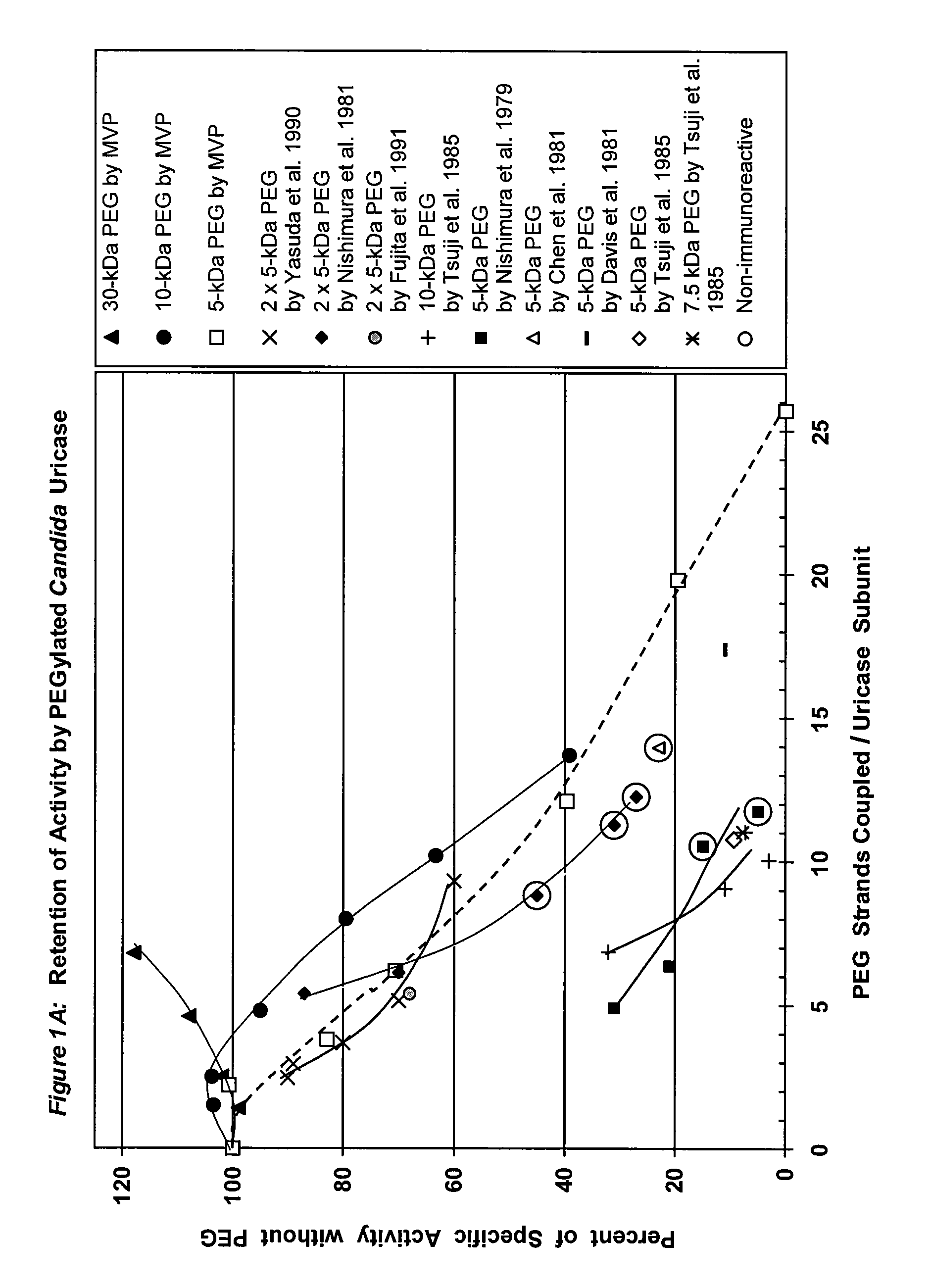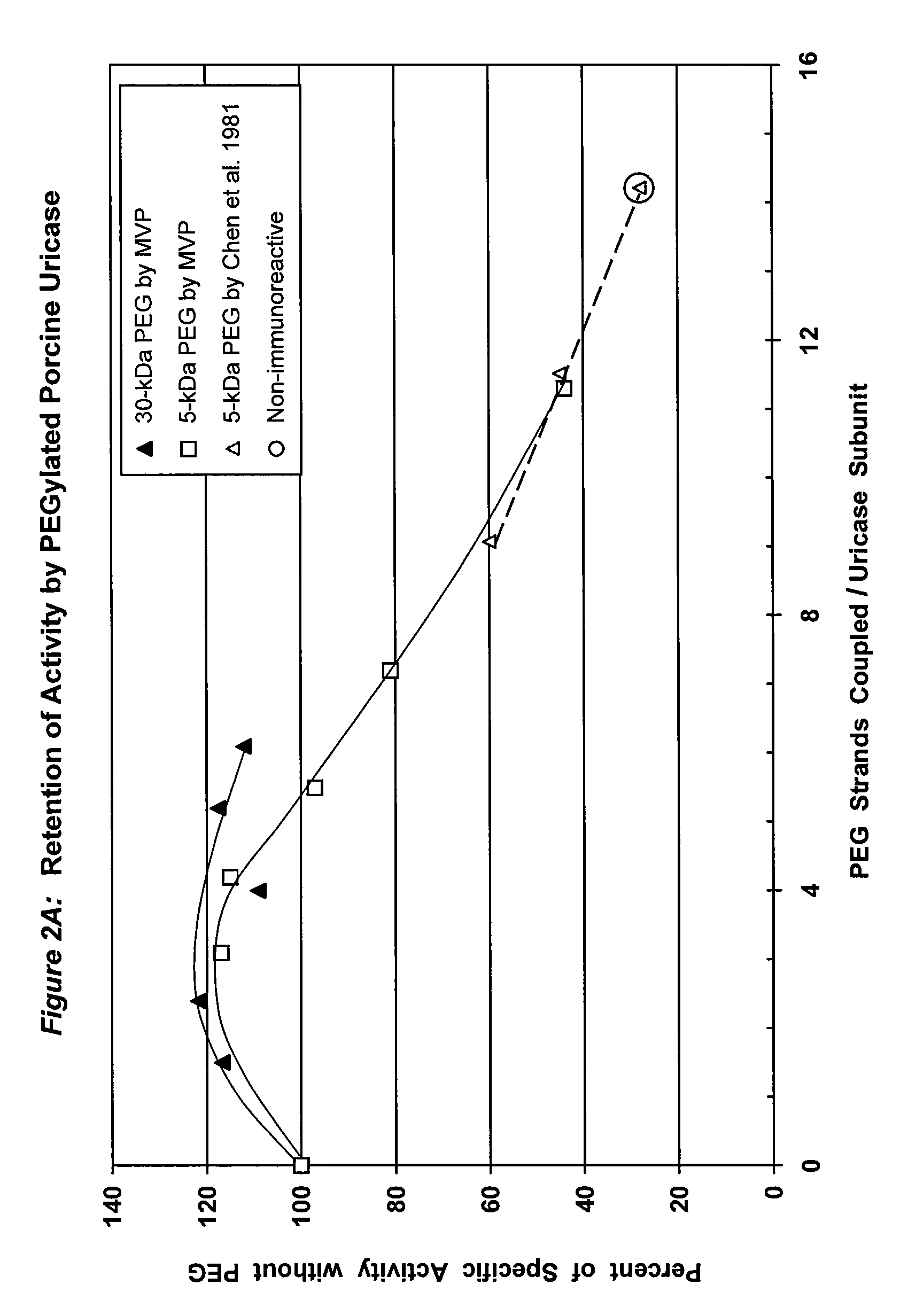PEG-urate oxidase conjugates and use thereof
a technology of uric acid and conjugates, which is applied in the field of peg-urate oxidase conjugates, can solve the problems of adverse effects, inability to meet the needs of uric acid production, and inability to meet the needs of uric acid production, and achieve the effect of lowering uric acid levels
- Summary
- Abstract
- Description
- Claims
- Application Information
AI Technical Summary
Benefits of technology
Problems solved by technology
Method used
Image
Examples
example 1
Purification of the Tetrameric Form of Uricase
[0064]The tetrameric form of uricase (molecular weight ca. 140 kDa) was purified from a solution of porcine liver uricase by preparative size-exclusion or ion-exchange chromatography, followed by analytical size-exclusion chromatography. Porcine liver uricase was obtained from Sigma-Aldrich, St. Louis, Mo., catalog No. U3250 or U3377; or Boehringer Mannheim, Indianapolis, Ind.
[0065]Preparative and analytical size—exclusion chromatography were performed at pH 10-10.5, preferably 10.2, in 10 mM sodium carbonate buffer containing 0.1 M NaCl on Superdex 200 columns that had been previously calibrated with proteins of known molecular weight. Superdex was obtained from Amersham Pharmacia, Piscataway, N.J. Any buffer may be used that is capable of maintaining the desired pH and that is compatible with the chemistry to be used for subsequent PEG coupling. Such buffers are well known in the art. The ultraviolet absorbance of the eluate from the p...
example 2
PEG Coupling to Tetrameric Porcine Uricase
[0068]To a solution of tetrameric uricase in 0.1 M sodium carbonate buffer, pH 10.2, 10-200 moles of an activated derivative of monomethoxyPEG, e.g., the 4-nitrophenyl carbonate (NPC-PEG), of various sizes (5 kDa to 30 kDa) were added for each mole of uricase subunit (molecular weight 35 kDa). These and other suitable activated PEGs are available from Shearwater Polymers. Instructions for coupling these PEGs to proteins are given in the catalog of Shearwater Polymers, on the Internet at www.swpolymers.com, and in J M Harris, et al., (Eds.) (1997) Poly(ethylene glycol) Chemistry and Biological Applications. ACS Symposium Series 680, Washington, D.C.: American Chemical Society. The coupling reaction was allowed to proceed at 0-8° C. until the extent of PEG coupling no longer changed significantly with time. Unreacted PEG was then removed from the reaction product by chromatography and / or ultrafiltration.
[0069]The number of strands of PEG coupl...
example 3
Properties of PEG Conjugates of Tetrameric Recombinant PBC Uricase
[0071]Recombinant pig-baboon chimeric (PBC) uricase cDNA was subcloned into the pET3d expression vector (Novagen, Madison, Wis.) and the resultant plasmid construct was transformed into and expressed in a strain of Escherichia coli BL21(DE3)pLysS (Novagen). These procedures were carried out using methods well known in the art of molecular biology. See Erlich (1989); Sambrook, et al., (1989); Ausubel, F, et al., (Eds.), (1997) Short Protocols in Molecular Biology. New York: John Wiley & Sons.
[0072]FIG. 6 shows the deduced amino acid sequence of PBC uricase (amino acids 1-225 of SEQ ID NO: 1 and amino acids 226-304 of SEQ ID NO: 2), compared with the porcine (SEQ ID NO: 1) and baboon (SEQ ID NO: 2) sequences. Residues in the baboon sequence that differ from those in the porcine sequence are shown in bold type. The porcine and baboon sequences were first determined by Wu, et al., (1989) and were confirmed by the present ...
PUM
 Login to View More
Login to View More Abstract
Description
Claims
Application Information
 Login to View More
Login to View More - R&D
- Intellectual Property
- Life Sciences
- Materials
- Tech Scout
- Unparalleled Data Quality
- Higher Quality Content
- 60% Fewer Hallucinations
Browse by: Latest US Patents, China's latest patents, Technical Efficacy Thesaurus, Application Domain, Technology Topic, Popular Technical Reports.
© 2025 PatSnap. All rights reserved.Legal|Privacy policy|Modern Slavery Act Transparency Statement|Sitemap|About US| Contact US: help@patsnap.com



